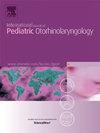Global tonsillectomy practice patterns – A survey study of pediatric otolaryngologists
IF 1.2
4区 医学
Q3 OTORHINOLARYNGOLOGY
International journal of pediatric otorhinolaryngology
Pub Date : 2025-02-19
DOI:10.1016/j.ijporl.2025.112276
引用次数: 0
Abstract
Objective
There is variation in surgical techniques and postoperative management of tonsillectomy globally. Our objective was to consolidate international similarities and differences in tonsillectomy management by pediatric otolaryngologists.
Methods
This cross-sectional survey study was conducted from April 4 to May 16, 2024. It involved a 55-item questionnaire distributed online to an international sample of pediatric otolaryngologists via an international WhatsApp group comprising pediatric otolaryngologists from various countries. The study achieved responses from 132 out of 293 invited pediatric otolaryngologists (45.1 % response rate). Participants were from 22 countries. Eligibility included proficiency in English and currently practicing pediatric otolaryngology.
Results
Among respondents, the majority primarily performed extracapsular tonsillectomy (44.7 %), followed by those who used both intracapsular and extracapsular tonsillectomy equally (34.8 %), and those who predominantly performed intracapsular tonsillectomy (20.5 %). Ideal patient candidates for extracapsular tonsillectomy included those with recurrent tonsillitis (70.5 %), recurrent peritonsillar abscesses (67.4 %), and obstructive sleep apnea (46.2 %). Ideal candidates for intracapsular tonsillectomy were those with obstructive sleep apnea (50.0 %) and bleeding disorders (38.6 %). Intracapsular tonsillectomy adoption was notably high in this cohort, with 68.8 % of European respondents favoring intracapsular tonsillectomy. Postoperative pain management varied, with 76.5 % of respondents using acetaminophen, 77.3 % using ibuprofen, and 28.8 % prescribing opioids, primarily oxycodone (48.6 %). Access to polysomnography was reported by 84.0 % of respondents. Common indications for inpatient admission included age under three (75.8 %), medical comorbidity (71.2 %), and severe sleep apnea (59.1 %).
Conclusion
This study highlights the increasing adoption of intracapsular tonsillectomy and the need for comprehensive guidelines addressing the observed global variability in practices.
Level of evidence
4.
全球扁桃体切除术实践模式-儿科耳鼻喉科医生的调查研究
目的世界各国扁桃体切除术的手术技术和术后处理存在差异。我们的目的是巩固国际上儿童耳鼻喉科医生扁桃体切除术处理的异同。方法横断面调查研究于2024年4月4日至5月16日进行。该研究涉及一份55项问卷,通过一个由来自不同国家的儿科耳鼻喉科医生组成的国际WhatsApp群,在线分发给国际儿科耳鼻喉科医生样本。该研究获得了293名受邀儿科耳鼻喉科医生中的132名的回复(45.1%的回复率)。参与者来自22个国家。合格条件包括英语熟练程度和目前从事儿科耳鼻喉科工作。结果在应答者中,大多数主要行囊外扁桃体切除术(44.7%),其次是同时行囊内和囊外扁桃体切除术(34.8%),以及主要行囊内扁桃体切除术(20.5%)。扁桃体囊外切除术的理想患者包括复发性扁桃体炎(70.5%)、复发性扁桃体周围脓肿(67.4%)和阻塞性睡眠呼吸暂停(46.2%)。患有阻塞性睡眠呼吸暂停(50.0%)和出血性疾病(38.6%)的患者是囊内扁桃体切除术的理想患者。在这个队列中,采用囊内扁桃体切除术的人非常多,68.8%的欧洲受访者赞成囊内扁桃体切除术。术后疼痛处理各不相同,76.5%的受访者使用对乙酰氨基酚,77.3%使用布洛芬,28.8%开具阿片类药物,主要是羟考酮(48.6%)。84.0%的应答者报告获得了多导睡眠描记仪。住院患者的常见适应症包括3岁以下(75.8%)、医学合并症(71.2%)和严重睡眠呼吸暂停(59.1%)。结论:本研究强调了越来越多的采用囊内扁桃体切除术和需要一个全面的指导方针,以解决在实践中观察到的全球变异性。证据水平4。
本文章由计算机程序翻译,如有差异,请以英文原文为准。
求助全文
约1分钟内获得全文
求助全文
来源期刊
CiteScore
3.20
自引率
6.70%
发文量
276
审稿时长
62 days
期刊介绍:
The purpose of the International Journal of Pediatric Otorhinolaryngology is to concentrate and disseminate information concerning prevention, cure and care of otorhinolaryngological disorders in infants and children due to developmental, degenerative, infectious, neoplastic, traumatic, social, psychiatric and economic causes. The Journal provides a medium for clinical and basic contributions in all of the areas of pediatric otorhinolaryngology. This includes medical and surgical otology, bronchoesophagology, laryngology, rhinology, diseases of the head and neck, and disorders of communication, including voice, speech and language disorders.

 求助内容:
求助内容: 应助结果提醒方式:
应助结果提醒方式:


